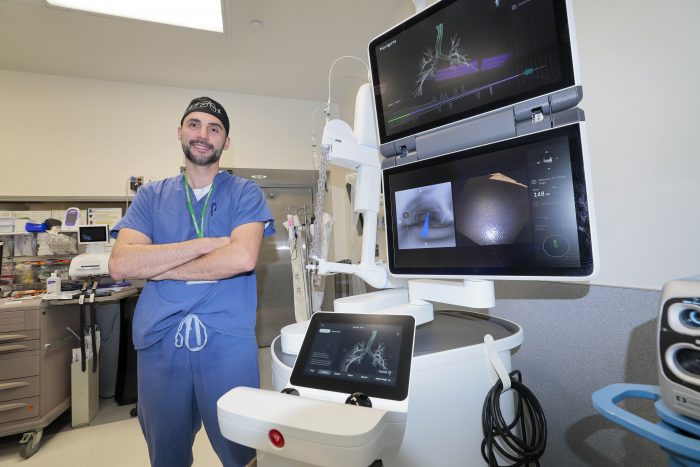New robotic system at Huntington Hospital speeds lung cancer detection
By Daniel Dunaief
Early and prompt detection of any cancer can and often does lead to better patient outcomes. With that in mind, Huntington Hospital recently added a new ION Robotic-Assisted Bronchoscopy to identify and perform biopsies on lung nodules. The robotic system, which the hospital has used on 25 patients, can trim the time for a diagnosis to as little as two to four weeks from as much as 70 days.
“We felt it would be an appropriate investment for the patient population so they wouldn’t have to travel to get a diagnosis in a timely manner,” said thoracic surgeon Dr. Andrea Carollo.
Lung cancer is the leading cause of cancer in Suffolk County, according to Dr. Nick Fitterman, Executive Director of Huntington Hospital. On top of that, two out of three lung cancers are in the outer third of the lungs, which the ION Robot specializes in sampling. Prior to the introduction of this system, patients either traveled to South Shore Hospital or would receive more extensive surgery to sample nodules.
For 90 percent of the patients, these nodules are benign. Not every nodule warrants a biopsy. Doctors use standard guidelines to monitor nodules and perform a procedure when these nodules require further investigation. With the ION Robotic-Assisted Bronchoscopy, these patients, who are under general anesthesia during the analysis, can go home the same day.
Get screened

Doctors typically recommend further evaluation when nodules come up on a CAT scan. While many residents receive screenings for breast cancer, colorectal cancer, cervical cancer and prostate cancer, few take the time to receive a lung screen, even among those who would benefit from initial and ongoing surveillance. About 79 percent of people eligible for a mammography get one. Of the people eligible for lung cancer screening, however, only about 6 percent receive them, Fitterman added.
“We are woefully, woefully deficient in lung cancer screening,” Fitterman said. “There’s an effective screening tool out there that is widely under utilized.”
The US Preventive Services Task Force recommends that high risk patients between 50 and 80 receive lung cancer screening. High risk patients include those who have smoked a pack of cigarettes a day for 20 years and are either current smokers or have quit smoking within the last 15 years.
“If you are a smoker, you should definitely get involved in lung cancer screening,” said Carollo.
By screening more patients, the hospital can offer immediate services, including surgery and various treatment regimes such as chemotherapy.
Options
Once a CAT scan reveals a nodule that warrants further imaging, doctors have three potential surgical options.
They can use trans-thoracic biopsy if the nodule is of a good size, is in a favorable location and the interventional radiologist performing the procedure thinks it is technically possible.
The overall risk of a collapsed lung is about 10 percent with this approach, but much higher in patients with central lesions and considerable emphysema. The risk is lower in patients with peripheral nodules and no emphysema. If a pneumothorax occurs, sometimes the patient requires a chest tube and hospital stay for as long as one to seven days.
With ION, the procedure is done through a breathing tube in the mouth and into the airways. The risk of a collapsed lung is less than one percent.
If there is a high suspicion of cancer, doctors can also go straight to surgery, which could be the case for a 50 year-old smoker with a 0.7 centimeter nodule that grew to one centimeter and shows activity on a PET scan.
In that case, the nodule and a portion of the lung are removed and sent to pathology, which evaluates it on site and, in about 20 minutes, can indicate whether it’s cancer. From there, doctors can take more lung tissue and lymph nodes for completion of a cancer operation. They review the tissue samples, which takes about 7 to 10 days to get a full answer of the type of cancer and stage if any mutations occurred.
The ION procedure, which has been available for over five years, decreases the risk of a collapsed lung and bleeding and provides an analysis of the nodule more rapidly. The complication rate is lower than with trans thoracic surgery.
At this point, Carollo is doing the majority of these ION-assisted biopsies, while pulmonologist, Dr. Nazir Lone, is doing some, as well.
In the ION procedure, doctors use a roller ball and a wheel that requires eye-hand coordination.
The company provides training to get certified and it takes about 10 to 15 of these procedures for a surgeon to feel comfortable doing them on his or her own, Carollo said.
Huntington Hospital ensures that doctors have sufficient training before allowing them to treat or diagnose patients. “Whenever we adopt any new technology or procedure, we have significant quality guardrails,” said Fitterman.
“We make sure that anyone operating on a machine first is proctored by someone else who is facile with it. They sign off and say, ‘Yes, you now met competencies. You can do it.’”
The speed of the analysis has important implications for patients. “If we can get this done in 30 days from the time we find something to treatment, that’s huge,” Carollo said. “Patients tend to have better outcomes. They live longer,” he continued. Delays over 50 days lead to decreased one and five year survival.
Other new developments
Huntington Hospital has several other new developments in the works.
The hospital is building a new cancer center in Greenlawn as well as expanding its labor and delivery capacity to provide services to more pregnant women.
Ever since St. Catherine of Siena closed its obstetrical unit on Feb. 1, Huntington Hospital has seen an increase in the number of pregnant patients.
The labor and delivery suites will add four beds and will refresh the space the hospital currently uses. The mother-baby units are “beautiful,” but the suites have to “catch up to that,” said Fitterman.
In the third quarter of next year, during the renovation, the labor and delivery areas will move to a place where the old emergency space had been. The improvements are expected to take about three months.







